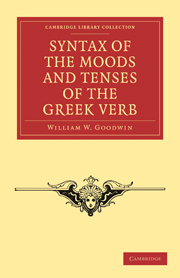Book contents
- Frontmatter
- PREFACE TO THE SECOND EDITION
- Contents
- CHAPTER I GENERAL VIEW OF THE MOODS
- CHAPTER II USE OF THE TENSES
- CHAPTER III THE PARTICLE ῞AN
- CHAPTER IV USE OF THE MOODS
- CHAPTER V THE INFINITIVE
- CHAPTER VI THE PARTICIPLE
- CHAPTER VII VERBAL ADJECTIVES IN -τέος
- APPENDIX I
- APPENDIX II
- INDEX TO EXAMPLES
- ENGLISH INDEX
- GREEK INDEX
CHAPTER II - USE OF THE TENSES
Published online by Cambridge University Press: 07 September 2011
- Frontmatter
- PREFACE TO THE SECOND EDITION
- Contents
- CHAPTER I GENERAL VIEW OF THE MOODS
- CHAPTER II USE OF THE TENSES
- CHAPTER III THE PARTICLE ῞AN
- CHAPTER IV USE OF THE MOODS
- CHAPTER V THE INFINITIVE
- CHAPTER VI THE PARTICIPLE
- CHAPTER VII VERBAL ADJECTIVES IN -τέος
- APPENDIX I
- APPENDIX II
- INDEX TO EXAMPLES
- ENGLISH INDEX
- GREEK INDEX
Summary
§ 8. 1. There are seven Tenses,–the Present, Imperfect, Perfect, Pluperfect, Aorist, Future, and Future Perfect. The Imperfect and Pluperfect occur only in the Indicative; the Futures are wanting in the Subjunctive and Imperative.
2. These tenses are divided into primary and secondary; the primary tenses being those which refer to present or future time, and the secondary being those which refer to past time.
The primary tenses of the Indicative are the Present, Perfect, Future, and Future Perfect. The secondary tenses are the Imperfect, Pluperfect, and Aorist.
Note. This distinction will be more fully explained at the end of this chapter, §§ 31–35.
§ 9. In speaking of the time denoted by any verb, we must distinguish between time which is present, past, or future with reference to the time of the speaker or writer (that is, time absolutely present, &c.), and time which is present, past, or future with reference to the time of some other verb with which the verb in question is connected (that is, time relatively present, &c.). Thus, when we say τοῦτο ἀληθές ἐστιν, this is true, ἐστίν denotes time present with reference to the time of speaking: but when we say ἔλεξε τοῦτο ἀληθὲς εἶναι, or ἔλεξεν ὅτι τοῦτο ἀληθές ἐστιν (or εἴη), he said that this was true (i. e. he said “this is true”.)
- Type
- Chapter
- Information
- Syntax of the Moods and Tenses of the Greek Verb , pp. 3 - 54Publisher: Cambridge University PressPrint publication year: 2010First published in: 1867

